Juyong Pass (居庸关) is located in Changping District, about 50 kilometers from Beijing. Its name dates back to the Qin Dynasty when it was built by Emperor Qin Shi Huang, who relocated prisoners, soldiers, and conscripted laborers here, hence the name “Juyong,” meaning “residence of conscripts.” In the Han Dynasty, it continued to be known as Juyong Pass, while during the Three Kingdoms period it was called West Pass. The Northern Qi Dynasty renamed it Nakun Pass, and in the Tang Dynasty, it was known by various names, including Juyong Pass, Jimen Pass, and Jundu Pass.
Juyong Pass is a strategically significant location, historically coveted by military strategists. It connects to Lulong and Jieshi fortresses in the east and the Taihang and Chang Mountains in the west, making it a crucial defensive stronghold. The pass has two main gates: the southern gate, called “Nankou,” and the northern gate, known as “Juyong Pass.” The existing structure was built under the supervision of General Xu Da, dispatched by the Ming Dynasty’s founding emperor, Zhu Yuanzhang, and serves as the northwestern gateway to Beijing.
The pass is flanked by majestic mountains, with an 18-kilometer-long valley known as “Guangou” running through it. This area is renowned for its beautiful scenery, featuring clear streams, lush peaks, vibrant flora, and the melodies of mountain birds. Due to its picturesque landscapes, Juyong Pass is recognized as one of the “Eight Great Sights of Yanjing.”
Table of Contents
- Basic Information
- Location and Transporation
- Highlights of Juyong Pass Great Wall
- Map and Recommended Routes
- Vlog about Juyong Pass Great Wall
- Best Time to Visit
- Nighttime Tour at Juyong Pass Great Wall
- A Brief History of Juyong Pass Great Wall
- Useful Tips Summarized from Reviews
- Other Sections of Great Wall in Beijing
- Explore Beijing Like A Local
Basic Information
| Estimated Length of Tour | Over 3 hours |
| Opening Hours | 8.00 – 17.00 (1st April – 31st October) 8.30 – 16.30 (1st November – 31st March the next year) |
| Ticket Price | 40 RMB (1st April – 31st October) 35 RMB (1st November – 31st March the next year) |
| Telephone Number | 0086-010-60761005 |
| Best Time to Visit | May to October |
Location and Transporation
Juyong Pass is a mountain pass located in the northern part of China, approximately 50 kilometers northwest of Beijing. As the main route between Beijing and the northern provinces of China, it is one of the three most important passes of the Great Wall of China, along with Shanhaiguan Pass and Jiayuguan Pass. To get there, you can choose one of the following ways:
From Deshengmen: Take bus 919 towards Yanqing and get off at Juyong Pass Station.
From Deshengmen: Take express bus 345 and get off at Changping Dongguan. Transfer to bus 314 or Chang 67 and get off at Dagongmen Station.
By Subway: Take the Changping Line to Changping Xishankou Station, exit from Exit C, then transfer to bus Chang 78 and get off at Dagongmen Station.
Highlights of Juyong Pass Great Wall
Cloud Platform (云台)

At the center of Juyong Pass lies the “Cloud Platform,” also known as the “Cross-Street Tower Base.” This platform gets its name from the impression it gives of being “in the clouds” when viewed from a distance. Constructed between 1342 and 1345 during the Yuan Dynasty, the Cloud Platform is built from white marble and stands at a height of 9.5 meters. Its top measures 25.21 meters in width (east to west) and 12.9 meters in length (north to south), while the base is 26.84 meters wide and 15.57 meters long.
The platform features a rectangular shape, larger at the base and tapering towards the top. Surrounding the top are stone railings, columns, balustrades, and dragon-head water spouts, all exemplifying Yuan Dynasty artistry. A central archway in the platform allows passage for pedestrians, carts, and horses, making it a functional and artistic masterpiece of large-scale stone carving from the Yuan era. Originally, three white pagodas stood atop the platform, but they were destroyed at the end of the Yuan Dynasty and the beginning of the Ming Dynasty. Later, the “Tai’an Temple” was constructed on the platform, which was burned down in 1702 during the reign of Emperor Kangxi in the Qing Dynasty. The Cloud Platform remains today, with pillar bases from the Tai’an Temple still visible on top.
Barbican and South-North Gates (券城与南北关)

The South Gate’s barbican is horseshoe-shaped, with the main gate facing north to south, topped by a double-eaved hip-and-gable roof tower standing 31.8 meters high. The barbican’s western side features a gate leading to the southern road of the pass. The barbican’s curved platform has a cannon emplacement and displays ancient Ming Dynasty lamps. The outer wall has battlements, while the inner wall is lower and without battlements, designed to trap invading forces within the barbican – an area known as the “urn city.” The design allowed defenders to close the main city gate, trap the enemy within the barbican by dropping a portcullis, and effectively capture them, leading to the phrase “catching a turtle in a jar.” Within the barbican, there is a temple dedicated to the god who protects the pass.
The North Gate functions similarly to the South Gate, with a rectangular barbican that also has a cannon emplacement. The gate of the northern barbican faces north, and within the barbican is a temple dedicated to the northern guardian deity, Zhenwu. This temple houses statues of the twelve zodiac gods and the deities of water and fire.
Ancient Cannons (古炮)
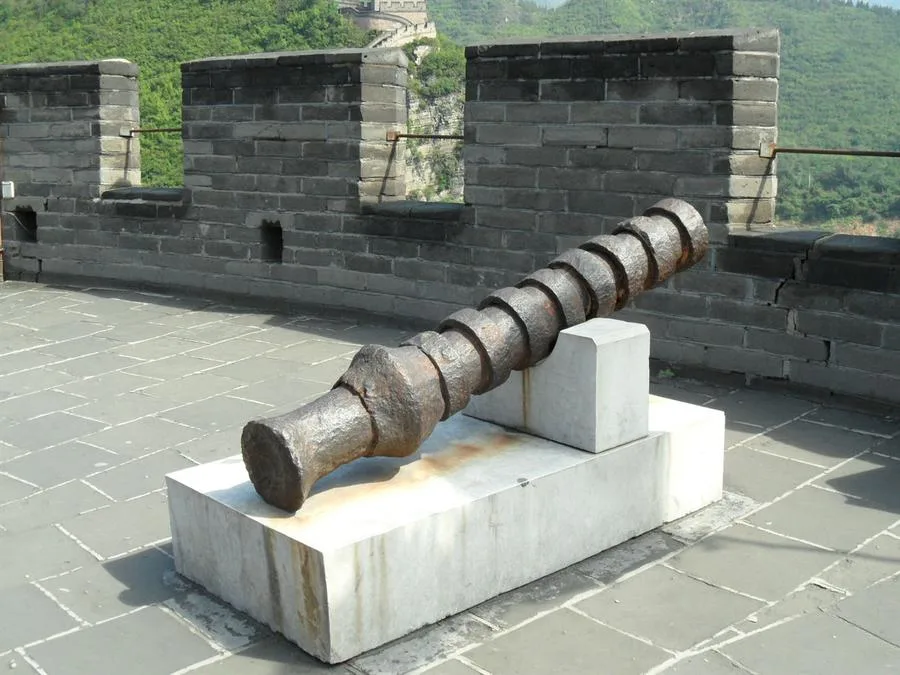
At Juyong Pass, both the South and North Barbicans showcase an impressive collection of ancient cannons. On the South Barbican’s wall, five cannons are displayed, including two “General Iron Cannons” each measuring 1.7 meters in length with an 8-centimeter caliber, and three “Bamboo Iron Cannons” each measuring 1.7 meters in length with a 15-centimeter caliber. The North Barbican also exhibits five cannons: two “General Iron Cannons” with lengths of 1.77 meters and 1.79 meters and calibers of 7 centimeters, and three “Bamboo Iron Cannons” with lengths of 1.08 meters, 1.5 meters, and 1.7 meters, with calibers of 14 centimeters and 8 centimeters.
The Ming Dynasty was a period of significant advancement in cannon manufacturing and usage in China. During the late Yuan Dynasty, Zhu Yuanzhang received a gift of ten new weapons called “fire lances” from Jia Li of Hezhou. These weapons used gunpowder to fire iron pellets, earning the name “fire dragon guns.” Following the establishment of the Ming Dynasty, a dedicated military armament bureau was created to develop and cast large cannons.
Cloud Platform Stone Carvings (云台石刻)
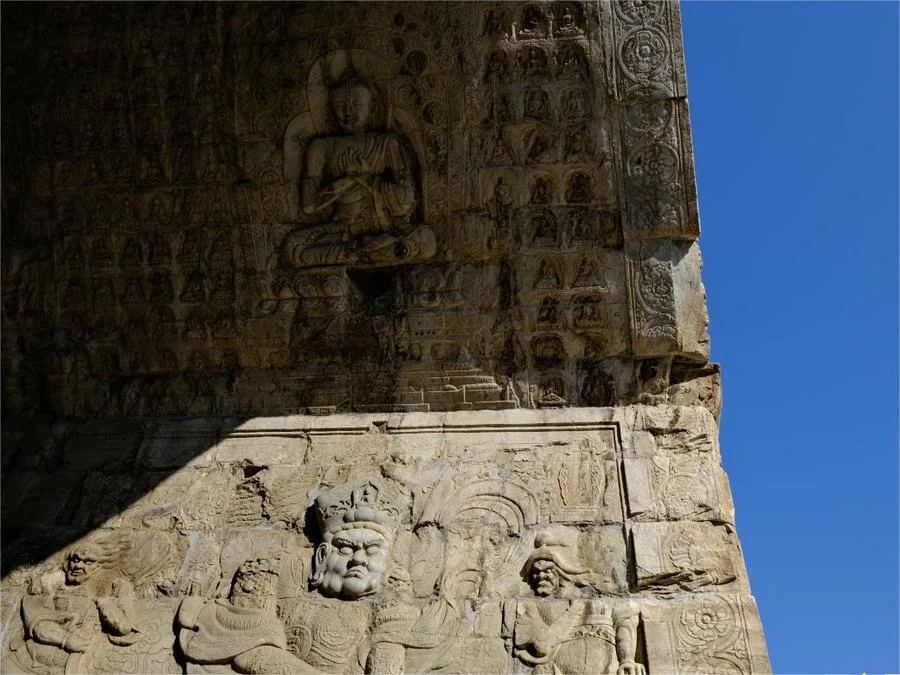
The Cloud Platform at Juyong Pass is renowned for its exquisite stone carvings, considered a masterpiece of art and craftsmanship. The walls and ceiling inside the arched gateway are adorned with intricately carved Buddha statues, showcasing vivid and lifelike depictions that reflect high-level artistry. These carvings also feature scriptures and mantras inscribed in six different scripts, typical of the Sakya sect of Tibetan Buddhism.
Upon entering the arched gateway, one can observe carvings of the Four Heavenly Kings on both sides. These kings are depicted as towering figures with fierce expressions, accompanied by ferocious demons. They are revered as protectors of the Buddhist faith and guardians of the nation. According to legend, during the Zhengde period of the Ming Dynasty, Emperor Wuzong Zhu Houzhao, disguised in common attire, attempted to secretly pass through Juyong Pass at night. His horse, frightened by the imposing statues of the Four Heavenly Kings, refused to move forward. In desperation, Emperor Wuzong ordered the statues to be blackened with smoke, enabling his passage through the gate.
Map and Recommended Routes

A) Full Loop Route
The full loop route is straightforward. No matter where you start your climb, you can complete a circuit and return to your starting point to descend. After completing the loop, you can decide whether to explore additional attractions based on your interests. Choose your starting point and parking area according to the specific sites you wish to visit.
B) Half Loop Route
The half loop route is divided into two sections using the line connecting the South and North Pass Gates as the boundary:
- West Line: Towers 7 to 14: This section is longer and steeper, especially the segment from the North Pass Gate to Tower 14.
- East Line: Towers 1 to 6: This section is shorter and gentler.
No matter whether you choose the East or West Line, there is a mountain trail in the middle that can offer a different experience or a shortcut.
Example Routes:
- Pure Great Wall Climb (East Line):
- Option 1: North Pass Gate Tower → Tower 1 → Tower 6 → South Gate Tower
- Option 2: South Pass Gate Tower → Tower 6 → Tower 1 → North Gate Tower
- Mixed Route with Mountain Trail (East Line):
- North Pass Gate Tower → Tower 1 → Tower 4 → Mountain Trail → Water Gate Tower → North Gate Tower
- This route allows you to skip Tower 5 by taking the mountain trail for a change of scenery and a shorter path.
Vlog about Juyong Pass Great Wall
Best Time to Visit
Spring: Juyong Pass transforms into a picturesque destination known as the “Spring Express,” attracting numerous photography enthusiasts.
Autumn: It’s the prime season for enjoying the vibrant red foliage, drawing countless visitors to admire the autumn scenery.
Additionally, from about April 29th to October 15th, Juyong Pass offers night tours of the Great Wall, providing visitors with a unique opportunity to explore the beauty of the wall at night.
Nighttime Tour at Juyong Pass Great Wall
Opening Hours: From May 1st to October 12th, the nighttime tour is available every Friday, Saturday, and on public holidays from 6:30 PM to 10:00 PM. Ticket sales and entry are available until 9:00 PM. The tour is not available on the last day of public holidays.
Ticketing Location: The ticketing for the nighttime tour is at the entrance near Parking Lot 2 (2号停车场检票处).
Night Tour Route:
- Start at Parking Lot 2: Enter from Parking Lot 2 and begin your adventure.
- Cloud Platform (云台): Explore the historical Cloud Platform.
- Ancient Inn Passageway (古客栈甬路): Walk through the ancient inn passageway.
- North Pass Gate Tower (北关城楼): Enjoy the view and watch performances under the North Gate Tower.
- East Mountain Great Wall, Tower 1 (东山长城1号敌楼): Reach the first enemy tower on the East Mountain section.
- Tower 4 (4号敌楼): Return from Tower 4 to complete the tour.
Performances: At the North Pass Gate Tower, you can enjoy a variety of performances including dance, martial arts, acrobatics, and traditional crafts. These performances blend contemporary art with traditional culture, offering visitors a captivating glimpse into the grandeur of Juyong Pass.
Ticket Price: The cost of the nighttime tour is 40 RMB.
A Brief History of Juyong Pass Great Wall
Juyong Pass, located northwest of Beijing, has been a vital military stronghold for over two millennia. As early as the Spring and Autumn period, the State of Yan controlled this strategic mountain pass. Ancient texts, including Lüshi Chunqiu and Huainanzi, identified it as one of China’s nine key fortresses.
During the Han Dynasty, Juyong Pass was well-developed as a fortified city. In 39 AD, the Eastern Han relocated residents east of the pass to defend against Xiongnu invasions. The pass continued to witness military conflicts, including battles against Xianbei forces in 118 AD and later engagements involving warlords like Liu Yu during the late Eastern Han.
The pass played a crucial role during the Sixteen Kingdoms period, as Murong forces frequently launched attacks through Juyong Pass. The Northern Wei Dynasty stationed troops here, and during the Northern Qi period (556 AD), the Great Wall was extended to connect with the pass.
In the Tang Dynasty, Juyong Pass was a key supply route, and military strategists emphasized its importance in defending Youzhou (modern-day Beijing). The Song Dynasty saw continued fortification of the pass, but it ultimately fell to the Jin and later the Mongols, who took control in 1211 AD. The Yuan Dynasty reinforced it with stone structures for better defense.
The present-day Juyong Pass fortress was constructed in 1368 AD during the Ming Dynasty under generals Xu Da and Chang Yuchun. The complex includes city walls, watchtowers, and temples. Despite falling into disrepair in the late Qing Dynasty, it remains a window into China’s military history. Recognized as a national heritage site in 1961, it was later inscribed as a UNESCO World Heritage Site in 1987.
Useful Tips Summarized from Reviews
Choose Your Route: There are two main routes to explore the Great Wall at Juyong Pass. The eastern route is relatively gentle, taking about half an hour to reach the Hero Stele (好汉碑). The western route is steeper, so choose according to your fitness level. If you have good stamina, you can climb one side and then the other.
Avoid Crowds: If you want to see the Great Wall without dealing with crowds, Juyong Pass is a great option. It’s less crowded compared to Badaling and Mutianyu, offering a more serene experience.
Bring Snacks and Water: There are limited food vendors available at Juyong Pass, so it’s advisable to bring your own snacks and water to stay energized during your visit.
Transportation: Transportation to Juyong Pass might not be as convenient as other sections like Badaling or Mutianyu. The 919 bus from Deshengmen is a direct route, but it can be slow, taking about one and a half hours. Keep in mind that there are no cable cars at Juyong Pass, so be prepared for a full hike without assistance.

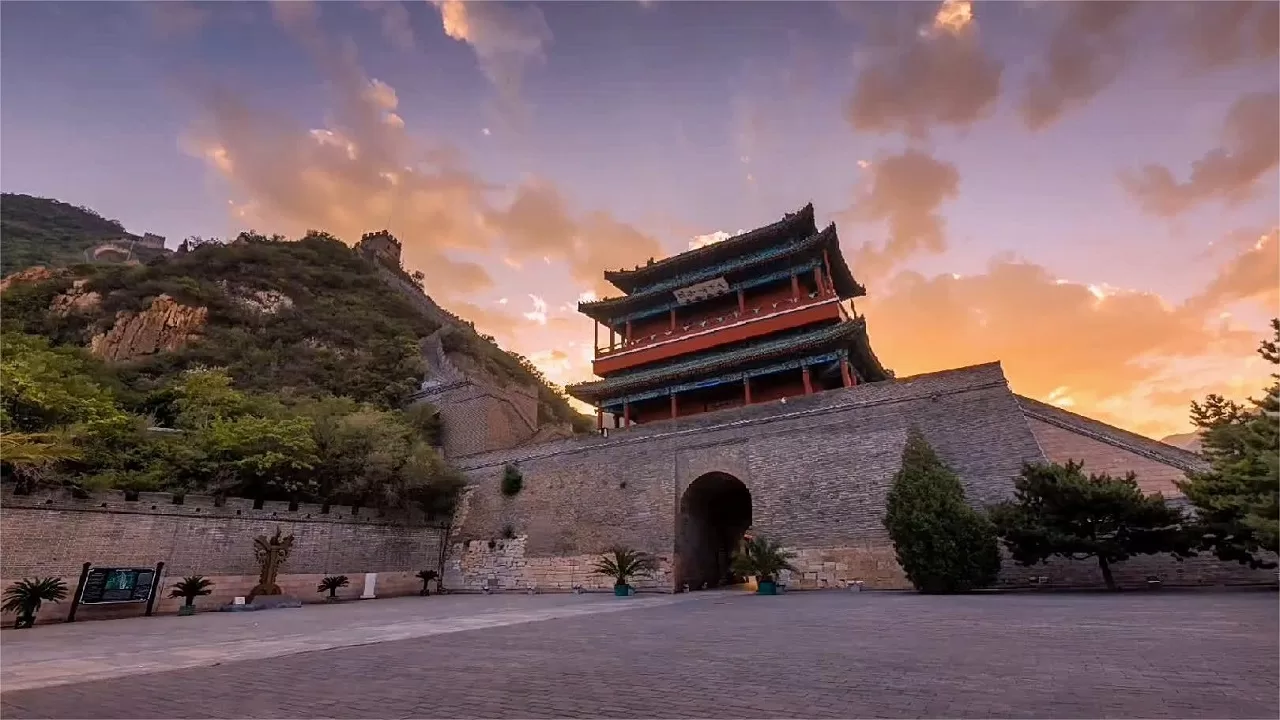
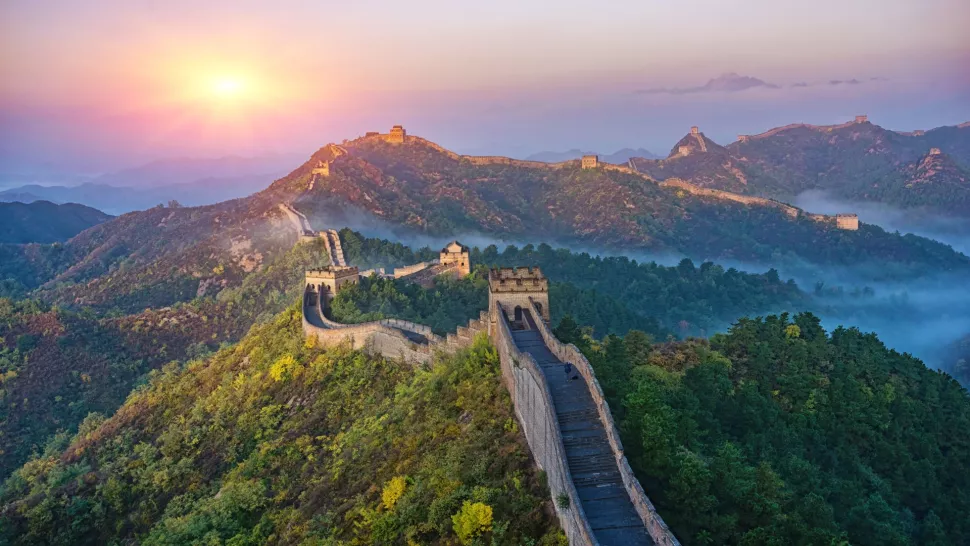


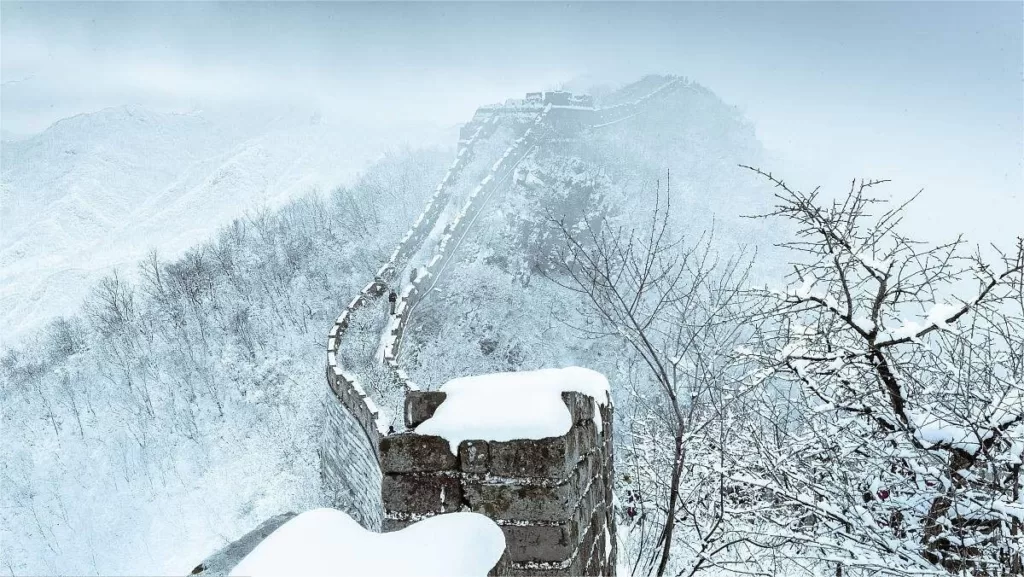
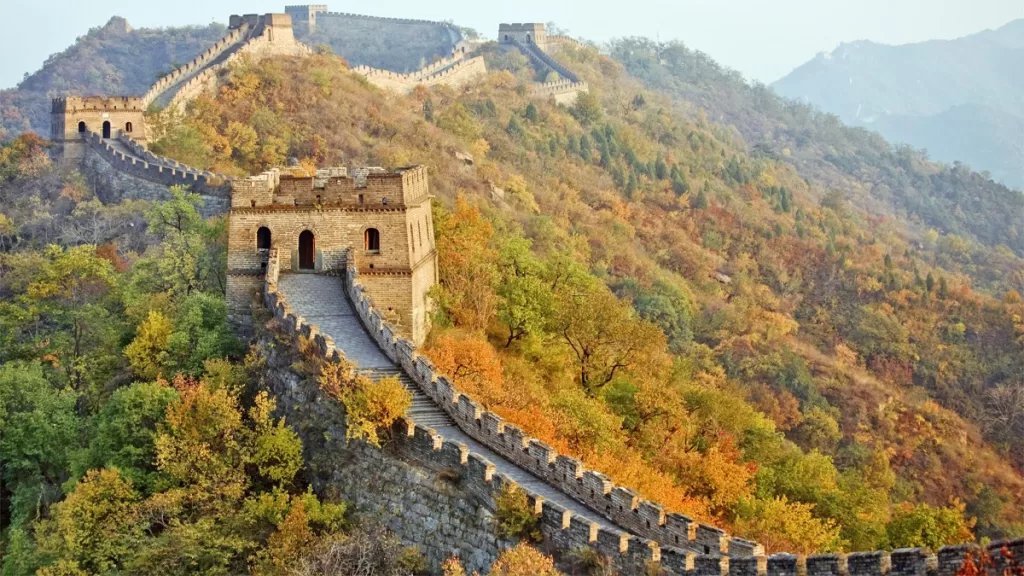


The Juyongguan Great Wall doesn’t require a reservation, no need to queue, and it’s not crowded, so you can take photos freely! We took a taxi to Parking Lot 1, entered, and turned right to the East Line. After snapping some photos, we returned to the West Line, hiked up to Yuntai (云台), known as the “Number One Pass Under Heaven” (天下第一雄关) and “He who doesn’t reach the Great Wall is not a hero” (不到长城非好汉), where we enjoyed the scenery… Read more »